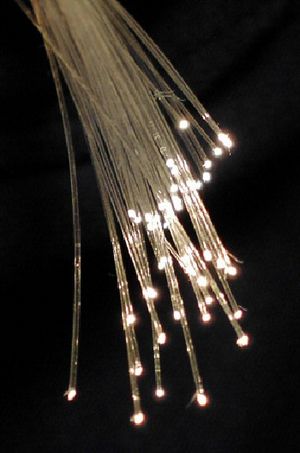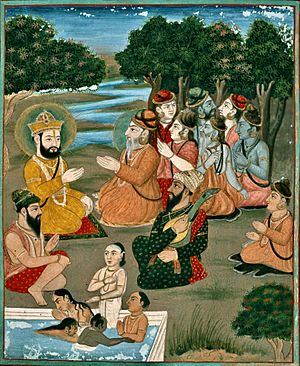Narinder Singh Kapany facts for kids
Quick facts for kids
Narinder Singh Kapany
|
|
|---|---|
| Born | 31 October 1926 |
| Died | 4 December 2020 (aged 94) California, U.S.
|
| Nationality | Indian American |
| Alma mater |
|
| Known for | Pioneering work on fibre optics |
| Awards |
|
| Scientific career | |
| Fields | Physics |
| Institutions |
|
Narinder Singh Kapany (born October 31, 1926 – died December 4, 2020) was an Indian-American physicist. He is widely known for his amazing work on fiber optics. Many people call him the 'Father of Fiber Optics'. He invented fiber optics, which helps us send information using light through tiny glass threads. Fortune magazine even called him one of the "Unsung Heroes of the 20th Century." India honored him with the Padma Vibhushan, a very high civilian award, after he passed away in 2021. He also worked as an officer for the Indian government. India's first Prime Minister, Jawaharlal Nehru, even offered him a top science job.
Contents
Early Life and Discoveries
Narinder Singh Kapany was born on October 31, 1926, in Moga, Punjab, India. He grew up in a Sikh family. He finished his schooling in Dehradun and then graduated from Agra University. He worked as an officer in the Indian Ordnance Factories Service.
In 1952, he moved to London to study at Imperial College London. There, he worked on his Ph.D. degree in optics. He earned his degree in 1955.
The Birth of Fiber Optics
At Imperial College, Kapany worked with a scientist named Harold Hopkins. They experimented with sending light through special fibers. In 1953, they successfully sent a clear image through a large group of these optical fibers. Other scientists had tried this before, but Kapany and Hopkins made the image quality much better.
Around the same time, a Dutch scientist named Bram van Heel developed something called optical cladding. This new invention, combined with Kapany's work, helped create the new field of fiber optics.
In 1960, Kapany wrote an article in Scientific American magazine. In this article, he first used the term 'fiber optics'. He also wrote the very first book about this new field. He became the most important researcher and spokesperson for fiber optics.
Kapany's Wide-Ranging Research
Kapany's research covered many areas. He worked on fiber-optics communication, lasers, and medical tools. He also studied solar energy and how to monitor pollution. He held over 120 patents for his inventions. He was a member of many important scientific groups. These included the Royal Academy of Engineering and the Optical Society of America.
His Amazing Career
Narinder Singh Kapany was also a successful businessman. He was very good at creating new ideas and managing technology.
Building Companies
In 1960, he started his first company, Optics Technology Inc. He was the chairman and director of research for 12 years. In 1967, his company became public, meaning people could buy shares in it. They also bought other companies and worked with partners around the world.
In 1973, Kapany started another company called Kaptron Inc. He was its president and CEO until 1990. Then, he sold Kaptron Inc. to a company called AMP Incorporated. For the next nine years, he worked at AMP as a top technologist. Later, he founded K2 Optronics. He also served on the boards of many other companies.
Teaching and Writing
Kapany was also a dedicated teacher and academic. He taught and guided students at the University of California, Berkeley (UCB). He also taught at the University of California, Santa Cruz (UCSC). At UCSC, he started a center for innovation and entrepreneurship. He led this center for seven years. He was also a visiting professor at Stanford University.
As an author, Kapany wrote over 100 scientific papers. He also wrote four books about opto-electronics and entrepreneurship. He gave many lectures to scientific groups all over the world.
Giving Back and Art
Narinder Singh Kapany was a generous philanthropist. He cared deeply about education and the arts.
He was the founding chairman of the Sikh Foundation. He supported its activities for over 50 years. The Foundation works with international groups to publish books and support arts and education. In 1998, Kapany gave money to create a special Sikh Studies program at the University of California, Santa Barbara.
In 1999, he donated $500,000 to the Asian Art Museum in San Francisco. This gift helped create a gallery to show his collection of Sikh art. He also gave money to the University of California, Santa Cruz to create a special program in optoelectronics. In 2012, he set up another program at UC Santa Cruz for entrepreneurship. He was also a trustee for the University of California, Santa Cruz Foundation.
Art Collector and Artist
Kapany was a passionate collector of Sikh art. He loaned many paintings and objects for a big exhibition called "Arts of the Sikh Kingdoms." This exhibition traveled to famous museums in London, San Francisco, and Toronto. He also organized another exhibition in 1992 called "Splendors of the Punjab."
As an artist himself, Kapany created unique sculptures. His art was shown in museums and galleries in San Francisco, Chicago, and other cities.
Awards and Honors
In 2021, Narinder Singh Kapany was given the Padma Vibhushan award after he passed away. This is India's second highest award for civilians. He also received the UC Santa Cruz Foundation Fiat Lux Award in 2008. In 2004, he received the Pravasi Bharatiya Samman. This award honors people of Indian origin who have made great achievements abroad.
In 1999, Fortune magazine named him one of seven "unsung heroes" of the 20th century. Time magazine also included him on their list of the top ten scientists of the 20th century.
Personal Life
Narinder Singh Kapany married Satinder Kaur in London in 1954. His wife, Satinder Kaur, passed away in 2016.
Death
Narinder Singh Kapany died on December 4, 2020, at the age of 94.
See also
 In Spanish: Narinder Singh Kapany para niños
In Spanish: Narinder Singh Kapany para niños



